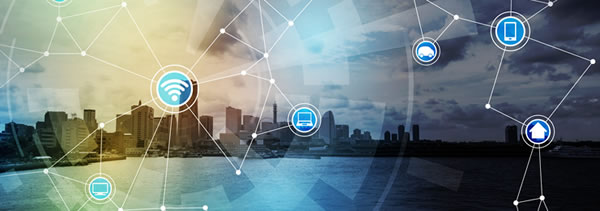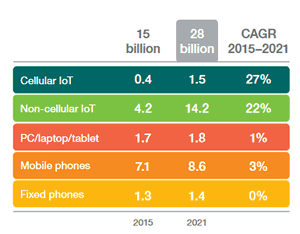Connectivity and computing approaches to leverage the Internet of Things (IoT) from a data and communication perspective.
With the rise of the IoT, there is obviously an avalanche of data being added to the networks and data processing, storage and analysis platforms of this digital world.
Knowing that we are really just at the beginning of the Internet of Things evolution, except perhaps for some industries such as utilities, that is good news for many ICT companies and infrastructure providers. In the field of consumer applications, the IoT today really still is close to nowhere. So, imagine where we’re going in an already very data-intensive environment which really is just beginning to see the true impact of the Internet of Things data.

Cloud and network/communication technologies drive evolutions in the Internet of Things (and vice versa)
A broad range of companies and service providers is benefiting from yet another data explosion, caused by the Internet of Things. Among them are those that provide the infrastructure and connectivity which is required to transport, store, protect and leverage all this Internet of Things data. Note: not all IoT applications are as data-intensive than those you might find in industrial environments. Internet of Things applications in areas such as smart parking or smart farming have small data needs.
Still, connectivity and networks have to adapt to an IoT world. It’s not a cooincidence that a company such as Cisco, for instance, is claiming a leading position in the IoT space as, even if it’s evolving, its core business is still very much about networks. While numerous new forms of network and connectivity technologies and of course the cloud have enabled, or better accelerated, the rise of the Internet of Things (and vice versa, as the cloud and IoT are strongly linked), IoT also impacts network and infrastructure technology evolutions.
Along with demands for increased capacity and intelligence within networks, as a consequence of digital transformation, there is also a new IT infrastructure paradigm whereby capacity, computing, connectivity and cloud technologies are moving closer to the devices themselves, closer to the edge of the network. Edge computing is the name and it’s becoming important. Here as well, Cisco is a key driver with its fog computing.
Evolving network technologies to optimize bandwidth
There isn’t one single form of network and data technology that solves all data and analytics challenges and possibilities brought upon us by various usage scenarios in the Internet of Things.
There also isn’t a single type of connectivity solution that connects people, things and networks in shorter ranges. As you know, IoT is an umbrella term for many possible applications in many possible industries where several technologies can be more relevant than others and de facto it’s always a mix in IoT.
The impact of the nascent deluge of data, mainly unstructured data, coming from the Internet of Things, is a challenge for networks across the globe. In a world where the need for bandwidth already keeps accelerating for a myriad of reasons, ranging from mobile data and video to ‘bandwitdh-intensive’ applications such as videoconferencing and ever bigger files, the challenge is on, for the Internet and for corporate networks.
It’s one of the reasons why in the context of Wide Area Networks (WAN) you see a gradual shift towards hybrid networking with added intelligence to optimally use and scale available capacity and a shift towards network function virtualization (NFV) and software-defined networking (SDN) to make networks more available, faster and smarter (read: far more based on software). Connecting millions and soon billions of devices does lead to new WAN technologies indeed.
The connectivity and network technologies for Internet of Things data
Next to these evolutions in network technologies, which are about more than just the Internet of Things but about ongoing digitization in general, there are also the numerous connectivity technologies which are more related with the Internet of Things itself.
From Bluetooth and NFC to WiFi and ZigBee
Examples include short range wireless connectivity solutions such as RFID, NFC, Bluetooth, Wi-Fi and the specific approaches of a bunch of probably less familiar sounding things such as ZigBee, Z-Wave (for home automation) or UWB (Ultra Wide-Band).
Moreover, as mentioned, in some circumstances you need mobile networks or even satellite connections (an example at the bottom of this page) – and here again, there are additional flavors and standards.
Cellular IoT
Cellular networks play a big role too.

There will be approximately 28 billion connected devices in 2021 (according to Ericsson) and cellular IoT will grow from 0.4 billion devices connected via cellular networks in 2015 to 1.5 billion in 2021, representing a CAGR of 27 percent as you can see in the graphic.
In the context of cellular IoT we need to mention 5G in IoT (and depending on use case 2, 3 and 4G), LTE-M or LTE-MTC, NB LTE-M and NB-IoT (the latter two also classified under LPWAN technologies, see below). According to many NB-IoT is a potential killer of the low power wide area (LPWA) technologies, which operate in the unlicensed spectrum and which we cover below. Vodafone is pushing hard to get NB-IoT out everywhere (with Huawei).
However, with the IoT it’s not different than in other technologies: rarely there is a one-size-fits all. An example: Cisco has an offering which combines LPWAN (LoRa, see below), WiFi and cellular IoT into its own LoRaWAN offering.
LPWA(N) and beyond
Time to talk about these LPWA/LPWAN technologies. On top of cellular IoT, there are several other wireless network technologies, designed for the Internet of things. This is where the Low-Power Wide Area (LPWA) technologies and LPWANs (Low-Power Wide Area Networks) we cover below come into the picture.
As you might know many components of a longer range Internet of Things ecosystem such as sensors require little power and sometimes use data which are sent for a long period but with longer intervals and at a relatively low bit rate. LPWAN, which is wireless, can offer the connectivity which such devices need for a longer period of time as it is also low-power. There are various LPWAN platforms/technologies, including for example machine-to-machine (M2M) technology Weightless, Ingenu (with its RMPA technology for IoT and M2M), France-based Sigfox and LoRA/LoRaWan. As said, these wireless IoT connectivity solutions operate in the unlicensed spectrum, whereas cellular IoT does not.
Top image: Shutterstock – Copyright: chombosan – All other images are the property of their respective mentioned owners.

